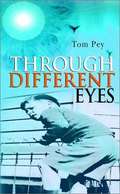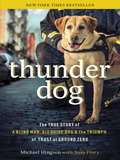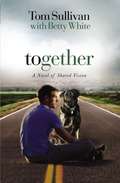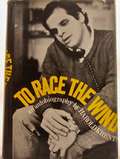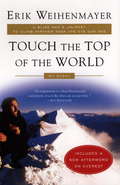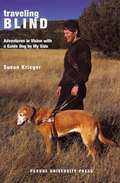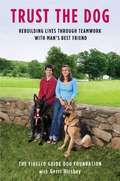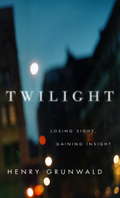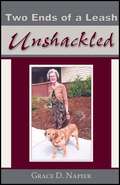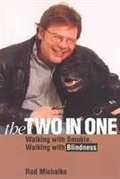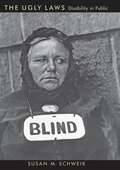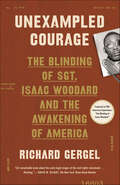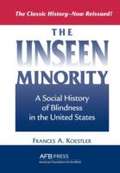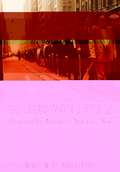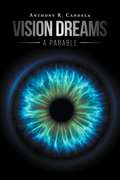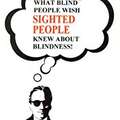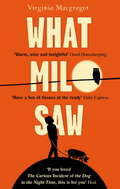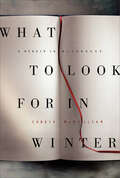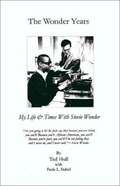Special Collections
Blindness and Visual Impairment Special Collection
Description: A collection featuring biographies, memoirs, fiction and non-fiction by and about members of the blind community. #disability
- Table View
- List View
Through Different Eyes
by Tom PeyAt age 38, a childhood accident came back to haunt Tom Pey and took his sight. Follow his struggle with depression, job loss and alcoholism. Follow his success as he finds a deeper meaning in life.
Thunder Dog
by Larry King and Michael Hingson and Susy FloryFaith. Trust. Triumph.
"I trust Roselle with my life, every day. She trusts me to direct her. And today is no different, except the stakes are higher." ?Michael Hingson
First came the boom?the loud, deep, unapologetic bellow that seemed to erupt from the very core of the earth. Eerily, the majestic high-rise slowly leaned to the south. On the seventy-eighth floor of the World Trade Center's north tower, no alarms sounded, and no one had information about what had happened at 8:46 a.m. on September 11, 2001?what should have been a normal workday for thousands of people. All that was known to the people inside was what they could see out the windows: smoke and fire and millions of pieces of burning paper and other debris falling through the air.
Blind since birth, Michael couldn't see a thing, but he could hear the sounds of shattering glass, falling debris, and terrified people flooding around him and his guide dog, Roselle. However, Roselle sat calmly beside him. In that moment, Michael chose to trust Roselle's judgment and not to panic. They are a team. Thunder Dog allows you entry into the isolated, fume-filled chamber of stairwell B to experience survival through the eyes of a blind man and his beloved guide dog. Live each moment from the second a Boeing 767 hits the north tower, to the harrowing stairwell escape, to dodging death a second time as both towers fold into the earth.
It's the 9/11 story that will forever change your spirit and your perspective. Thunder Dog illumiates Hingson's lifelong determination to achieve parity in a sighted world, and how the rare trust between a man and his guide dog can inspire an unshakable faith in each one of us.
Together
by Tom Sullivan and Betty WhiteFrom the book "If this dog loves me enough to lay down his life for my survival, how can I just give up?" One misstep on a mountain climbing trip plunged Brenden McCarthy into darkness by stealing his sight and everything else he held dear. But a too-independent guide dog named Nelson just might lead him back to life . . . if they don't kick him out of guide dog school first. Brenden can't accept the fact that he's lost his sight. And Nelson can't accept that he's been paired with someone other than his former master. Just as Brenden starts to live again, a devastating setback causes him to try to end it all. Brenden releases Nelson and sits down in the middle of an intersection. At that moment, everything changes when Nelson freely decides he'd rather join Brenden in death than live without him. Now they need a leap of faith and a love beyond words to make it.
Toothpaste and Railroad Tracks
by Kenneth JerniganThis is the eighth book in the Kernel Books Series--a series of books in which people who are blind tell about life situations and how they coped with them. "What do toothpaste and railroad tracks have in common? Just about the same that axes and law books do--nothing and everything. They are the building blocks of the routine of daily existence. In a very real sense they are the essence of humanity itself. When I was younger (maybe 40 years ago), there was a popular song called "Little Things Mean a Lot." It dealt with what the title implies, but its message was much more than that. It was that each little incident (relatively unimportant in and of itself) combines with all of the other trivial events that are constantly happening to us to form the pattern of our lives. It is not the major events but the recurring details that make us what we are--that determine whether we will succeed or fail, be happy and productive or sad and miserable. Other books in this series are available from Bookshare."
To Race the Wind
by Harold KrentsThe autobiography of Harold Krents, a young blind man who was a well-known lawyer in the early 1970's. Harold was the inspiration for the film and play, Butterflies Are Free.
Touch the Top of the World
by Erik WeihenmayerErik Weihenmayer was born with retinoscheses, a degenerative eye disorder that would leave him blind by the age of thirteen. But Erik was determined to rise above this devastating disability and lead a fulfilling and exciting life. In this poignant and inspiring memoir, he shares his struggle to push past the limits imposed on him by his visual impairment-and by a seeing world. He speaks movingly of the role his family played in his battle to break through the barriers of blindness: the mother who prayed for the miracle that would restore her son's sight and the father who encouraged him to strive for that distant mountaintop. And he tells the story of his dream to climb the world's Seven Summits, and how he is turning that dream into astonishing reality (something fewer than a hundred mountaineers have done). From the snow-capped summit of McKinley to the towering peaks of Aconcagua and Kilimanjaro to the ultimate challenge, Mount Everest, this is a story about daring to dream in the face of impossible odds. It is about finding the courage to reach for that ultimate summit, and transforming your life into something truly miraculous."I admire you immensely. You are an inspiration to other blind people and plenty of folks who can see just fine." (Jon Krakauer, author of Into Thin Air)
Traveling Blind
by Susan KriegerKrieger (feminist studies, Stanford U.) recounts her experiences as a newly blind person learning to navigate with her guide dog.
Trust the Dog
by Gerri HirsheyA groundbreaking look at the special bond between guide dogs and those who thrive with their help. From a pioneering guide dog organization comes the first book to explore one of the most profound and inspiring relationships between humans and animals. In Trust the Dog, the Fidelco Guide Dog Foundation introduces readers to a group of extraordinary people who, thanks to their guide dogs, flourish in a world that assumes the ability to see. Among them are a brother and sister who lost their sight at a very young age and whose dogs essentially helped them grow up, a Serbian girl who fled civil war to find new hope in America, and a newly blind single father determined to keep his family together against all odds. Through their experiences we discover the astonishing teamwork and devotion between people who are blind and their guide dogs, the intelligence and discipline that these animals unfailingly display, and the noble work of the nonprofit organization that for fifty years has been making it all possible. A heartwarming tribute to this unique relationship, Trust the Dog is sure to change how we think about man's best friend, and the possibilities of life without sight.
Twilight
by Henry Grunwald and Mark G. AckermannIn 1992, when Henry Grunwald missed a glass into which he was pouring water, he assumed that he needed new eyeglasses, not that the incident was a harbinger of darker times. But in fact Grunwald was entering the early stages of macular degeneration -- a gradual loss of sight that affects almost 15 million Americans yet remains poorly understood and is, so far, incurable. Now, in Twilight, Grunwald chronicles his experience of disability: the clouding of his sight, and the daily struggle to overcome its physical and psychological implications; the discovery of what medicine can and cannot do to restore sight; his compulsion to understand how the eye works, its evolution, and its symbolic meaning in culture and art. Grunwald gives us an autobiography of the eye -- his visual awakening as a child and young man, and again as an older man who, facing the loss of sight, feels a growing wonder at the most ordinary acts of seeing. This is a story not merely about seeing but about living; not merely about losing sight but about gaining insight. It is a remarkable meditation.
Two Ends of a Leash
by Grace D. NapierTwo Ends of a Leash: Unshackled is the life story of author Grace D. Napier.
Born blind, Grace came from a humble home in New Jersey. She began school when there were no special education programs for children who were blind. The teachers and principal regarded Grace as not only blind, but also mentally retarded. Because they misunderstood her disability, they ignored her, letting her sit idle at her desk every day. Nevertheless, Grace had a hunger to learn.
When her parents heard about a special education program in the next city, Grace met Miss Katharine Taylor, her new special education teacher. Grace's life was forever changed, thanks to the influence of this gifted teacher. Now eighty-five, Grace resides in Colorado after a long career of teaching children and graduate students at three universities.
Grace began using Seeing Eye dog guides when she was seventeen years old. She is now working with her ninth dog, Esma (shown on the front cover). Read her fascinating and inspiring story.
The Two-In-One
by Rod MichalkoWhen Rod Michalko's sight finally became so limited that he no longer felt safe on busy city streets, he began to search for a guide.
The Ugly Laws
by Susan M. SchweikThe murky history behind municipal laws criminalizing disabilityIn the late-nineteenth and early-twentieth centuries, municipal laws targeting "unsightly beggars" sprang up in cities across America. Seeming to criminalize disability and thus offering a visceral example of discrimination, these “ugly laws” have become a sort of shorthand for oppression in disability studies, law, and the arts.In this watershed study of the ugly laws, Susan M. Schweik uncovers the murky history behind the laws, situating the varied legislation in its historical context and exploring in detail what the laws meant. Illustrating how the laws join the history of the disabled and the poor, Schweik not only gives the reader a deeper understanding of the ugly laws and the cities where they were generated, she locates the laws at a crucial intersection of evolving and unstable concepts of race, nation, sex, class, and gender. Moreover, she explores the history of resistance to the ordinances, using the often harrowing life stories of those most affected by their passage. Moving to the laws’ more recent history, Schweik analyzes the shifting cultural memory of the ugly laws, examining how they have been used—and misused—by academics, activists, artists, lawyers, and legislators.
Undaunted by Blindness
by Clifford E. OlstromThe purpose of this book is to provide concise biographical information about four hundred notable blind persons. The people in this volume are but a small sample of the many thousands of notable blind persons in history.
Unexampled Courage
by Richard Gergel*The book that inspired the 2021 PBS American Experience documentary, The Blinding of Isaac Woodard.*How the blinding of Sergeant Isaac Woodard changed the course of America’s civil rights history.Richard Gergel’s Unexampled Courage details the impact of the blinding of Sergeant Woodard on the racial awakening of President Truman and Judge Waring, and traces their influential roles in changing the course of America’s civil rights history. On February 12, 1946, Sergeant Isaac Woodard, a returning, decorated African American veteran, was removed from a Greyhound bus in Batesburg, South Carolina, after he challenged the bus driver’s disrespectful treatment of him. Woodard, in uniform, was arrested by the local police chief, Lynwood Shull, and beaten and blinded while in custody.President Harry Truman was outraged by the incident. He established the first presidential commission on civil rights and his Justice Department filed criminal charges against Shull. In July 1948, following his commission’s recommendation, Truman ordered an end to segregation in the U.S. armed forces. An all-white South Carolina jury acquitted Shull, but the presiding judge, J. Waties Waring, was conscience-stricken by the failure of the court system to do justice by the soldier. Waring described the trial as his “baptism of fire,” and began issuing major civil rights decisions from his Charleston courtroom, including his 1951 dissent in Briggs v. Elliott declaring public school segregation per se unconstitutional. Three years later, the Supreme Court adopted Waring’s language and reasoning in Brown v. Board of Education.
The Unseen Minority
by Frances A. KoestlerThe book ia a definitive history of the societal forces affecting blind people in the United States and the professions that evolved to provide services to people who are visually impaired.
Veterans with a Vision
by Serge Marc DurflingerDurflinger (history, the University of Ottawa, Canada) chronicles advocacy by Canadian servicemen blinded in war, highlighting their efforts to help Canadian veterans and all blind citizens. The book begins with the establishment of the Canadian National Institute for the Blind in 1918 by 200 Canadian servicemen blinded in WWI, then continues with the formation of the Sir Arthur Pearson Association of War Blinded, which advocated for government benefits, job retraining, and other social programs. Key figures are profiled, and issues such as physical and psychological rehabilitation are discussed. The book is based on archival material from both organizations.
Vision Dreams
by Anthony CandelaIn this dystopian novella, Anthony Candela, a self-described “Trekker” and “secular humanist”, shows us the extremes to which societies will go if sufficiently frightened, especially if science and technology permit it. Individuals will do likewise in order to achieve, if not happiness, then at least relief from tyranny. In this story, the narrator, who both hovers above the action and is totally immersed in it, tells of the lengths he and his three co-adventurers go to achieve their goals. One wants an even chance at life and, oh yes, to be a star baseball player; another wants to fly. A third seeks true artistic sensuality, and the fourth wants nothing more than the Freudian essentials of success at love and work. Unfortunately the society they live in has hunkered down, devoting nearly all of its resources to self-protection and very little to everyday human comforts—all except for a small group of scientists who appear to be bucking the system.
Ultimately by extraction, this novella increases our understanding of what it means to live in a society that is supportive of its citizens’ daily happiness and humanity. Perhaps after reading it, you will be more on guard against what can happen when nations decide to be hypervigilant. As the plot unfolds, you will see the lengths to which people will go to achieve their humanity. In the midst of the subtle kinds of strife that leads many to live lives of quiet desperation, there are heroes willing to take risks.
Wall-To-Wall Thanksgiving
by Kenneth JerniganThis is the thirteenth book in the Kernel Series. Its chapters are: Don't Throw the Nickel Boy Was I Bamboozled Lessons from the Charcoal Pit Concerning Books, Lawn Mowers, and Bus Rides Children, Fruitcake, and Rectangles The Wall-to-Wall Thanksgiving Meeting the Challenge Daddy Read Me Walking the Balance Beam Big Enough to Ride the Bike and, of course, Dr. Jernigan's introduction, which ties together the featured vignettes. Other books in this series are available from Bookshare.
What Blind People Wish Sighted People Knew About Blindness! (Revised Edition)
by Harry Martin
Harry Martin became blind as the result of an eye disease he contracted while serving in the Navy in 1973. His eye condition began as a case of severe visual impairment, and progressed to total blindness over a period of twenty years. Harry lives with his wife, Carol, and his guide dog, Frankie in Orlando, Florida.
THIS BOOK IS A MUST READ FOR ALL SIGHTED PEOPLE!
Whether you know a blind person or not, you must read this book. The reader will gain a new understanding of what it is like to be blind, and to go blind. Find out why some blind people can see. Learn how guide dogs work. Discover how blind people do things without sight. If you have a blind relative, friend, spouse, or co-worker; this fascinating book will tell you how to relate to them better. Teachers, this book is an outstanding educational tool. Use it to teach your students all about blindness and the blind.
What Color is the Sun
by Kenneth JerniganA Kernel Book, this has life stories from 14 blind people.
What Milo Saw
by Virginia MacgregorA BIG story about a small boy who sees the world a little differently.
Milo curled his thumb and forefinger together to make a small hole and held his fingers up to Al's eyes.
'Look through here. That's what I see. Kind of, only worse.''Wow, that must be amazing.'Milo shrugged. 'Not really.''I mean, it makes you focus, doesn't it? I bet you see all kinds of stuff that other people miss.'
Nine-year-old Milo Moon has retinitis pigmentosa: his eyes are slowly failing and he will eventually go blind. But for now he sees the world through a pin hole and notices things other people don't. When Milo's beloved gran succumbs to dementia and moves into a nursing home, Milo soon realises there's something wrong at the home. So with just Tripi, the nursing home's cook, and Hamlet, his pet pig, to help, Milo sets out on a mission to expose the nursing home and the sinister Nurse Thornhill.
Insightful, wise and surprising, What Milo Saw is filled with big ideas and simple truths. Milo sees the world in a very special way and it will be impossible for you not to fall in love with him and then share his story with everyone you know.
What to Look for in Winter
by Candia McWilliamThe British literary sensation—“the most startling, discomforting, complicated, ungovernable, hilarious and heart-rending of memoirs ” (The Telegraph)—the story of a celebrated writer’s sudden descent into blindness, and of the redemptive journey into the past that her loss of sight sets in motion. Candia McWilliam, whose novels A Case of Knives, A Little Stranger, and Debatable Land made her a reader favorite throughout the United Kingdom and around the world, here breaks her decade-long silence with a searing, intimate memoir that fans of Lorna Sage’s Bad Blood, Mary Karr’s Lit, and Diana Athill’s Somewhere Toward the End will agree “cements her status as one of our most important literary writers beyond question” (Financial Times).
When The Blizzard Blows
by Kenneth JerniganThis is the seventh book in the Kernel Book Series. In these books, people who are blind share incidents from their lives and tell how they coped with them. Some are serious; some are humorous; all are thought-provoking. Other books in this series are available from Bookshare.
White Coat, White Cane
by David Hartman and Bernard AsbellThe woman's arthritic fingers feel gnarled and crooked, her knees lumpy rocks. But I can detect no swelling, so I press here, there, trying to rouse an inflamed spot. "What are you doing"she challenges. "You're blind!"
"I'm examining you. Haven't you ever been examined by a blind doctor before?"
She refuses to be humored. "That's silly. What can a blind doctor do?"
"I'm not sure, but we're going to find out..."
When David Hartman, blind since the age of eight, announced his intention to become a doctor, the reactions ranged from sympathy to ridicule. How could he diagnose his patients? Examine them, except by touch? Look through a microscope? Even understand what was being described?
The battle lines were drawn: David and his family on one side, the schools and society on the other. But with an incredible strength of purpose, David Hartman went on to become the first blind person in over 100 years to enter medical school. What is it like to adjust to a world of darkness? David Hartman lets us know bluntly, with real emotion, insight, and humor. He had to relearn the simplest things. He had to overcome mental obstacles that were at times more formidable than the physical ones. Yet he was determined to reach beyond his difficulties to fulfill an impossible dream.
His teachers were helpful, hostile, embarrassed, unsure-and in medical school he had to work twice as hard. The work had to be read to him or translated into Braille. Often he had to rely on a sighted person to confirm his diagnosis, and he needed a nurse to read the patients' charts to him. But he utilized all his other senses to achieve his greatest desire: helping to heal. His journey is a moving and inspirational story for us all.
The Wonder Years
by Ted Hull and Paula L. StahelTed Hull was not a singer or a musician, however he was very involved in Stevie Wonder's life and Motown. Ted was Stevie's teacher, mentor and companion.
